Content
- Characteristic
- Functions and properties
- Anatomy and structure
- Inflammation
- Classification
- Symptoms and Signs
- Causes
- Treatment methods
- Medications
- Folk remedies
- Physiotherapy
- Video about sciatic nerve inflammation
The sciatic nerve is an important element of the human peripheral nervous system. Quite often, patients experience symptoms of inflammation of the nerve tissues, which worsen the quality of life and can provoke concomitant deviations from the musculoskeletal system. To eliminate symptoms, you must first visit a doctor who will determine the severity of the symptoms and the optimal therapy regimen.
Characteristic
The sciatic nerve is part of the peripheral nervous system, that is, nerve endings that branch off from the spinal cord. It is the largest nerve in the patient's body, which is associated with the functions performed.
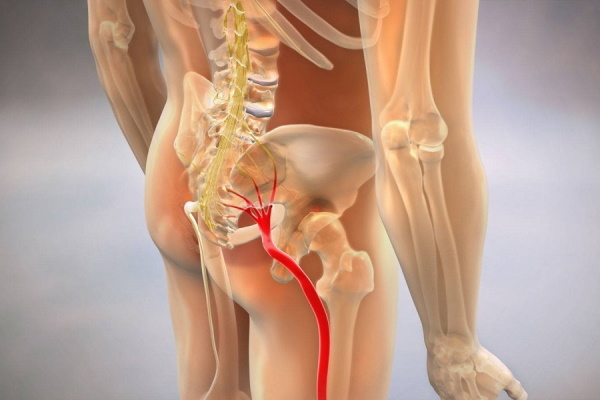
Like some other nerve endings, the sciatic nerve has 2 parts, divided into many branches. The structure of the nerve ending does not differ from other parts of the peripheral nervous system.
Functions and properties
The nerve ending has motor and sensory properties, like other parts of the spinal cord. The main function of the sciatic nerve is to provide nutrition to tissues, muscles, and also to prevent the development of neurosis.
Certain fibers are also responsible for the movement of the lower limbs, that is, muscle contraction after receiving a signal from the brain. The motor and sensory function of the nerve ending is disrupted when symptoms of inflammation appear, which affects the work of the entire musculoskeletal system.
Anatomy and structure
The sciatic nerve (symptoms of inflammation can occur in patients of different ages) has a standard structure, like all nerve endings of the spinal cord. The nerve begins in the region of the sacral plexus, after which it passes in the area of the gluteus maximus muscle, along the back of the thigh and lower leg. In the lower leg area, it branches into small nerve endings that nourish the tissues and provide the sensitivity of the skin in this area.
From the sacral spine there are 2 large branches, which gradually become thinner in the region of the legs. Like other nerve endings, the nerve has a myelin sheath, as well as an axon and bundles of nerve fibers, which provide sensory, motor functions. In the area of the nerve, along its entire length, there are vessels that provide blood supply to the tissues.
Inflammation
Inflammation of the nerve in medicine is called neuritis, but when the sciatic nerve endings are damaged, sciatica develops, since the roots are involved in the pathological process. The people call pathology radiculitis. When symptoms of pathology appear, not only damage to nerve tissues is noted, but also muscle fibers, skin, which is associated with impaired motor and sensory function.
Classification
Depending on the characteristics of the course of the pathological condition, it can be acute and chronic. Acute inflammation usually occurs suddenly and is accompanied by severe lumbar spine symptoms.
The chronic form develops in the absence of therapy in acute inflammation. In this case, the symptoms are exacerbated at regular intervals. As the pathological condition progresses, the frequency of the onset of symptoms increases, and their severity also increases.
Experts also divide the disease, depending on the degree of tissue damage, into unilateral and bilateral. In the first case, the nerve ending on one side of the body is affected, that is, one leg is involved in the pathological process.
With bilateral lesion, there is a violation of the motor activity of the legs, and also there are concomitant deviations from the musculoskeletal system. Depending on the severity of the symptoms of pathology, experts distinguish several stages of its development.
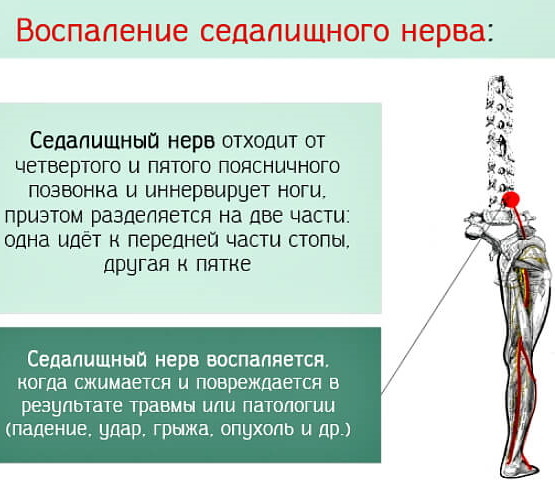
| Stage | Features of the flow |
| Initial | At this stage, the first symptoms appear in patients, which they do not always attribute to pathologies of the spinal column and spinal cord. In most cases, at this stage, the patient does not visit the doctor, uses various methods to eliminate discomfort, or suffers pain. |
| Progressive | At a progressive stage, all symptoms appear in an acute form, which significantly worsens the patient's condition and leads to the appearance of concomitant symptoms. The patient notes an aggravation of discomfort with movements, as well as the appearance of systemic disorders. Home treatment methods do not bring a pronounced result, so the patient visits a doctor. |
| Launched | A neglected course of the disease is observed in the absence of therapy at the initial or progressive stage. In this case, it is possible not only to aggravate the symptoms of the underlying disease, but also to develop severe complications from the internal organs. This stage requires the placement of the patient in a hospital and the provision of comprehensive care. |
In the acute course of the disease, the transition from one stage to another occurs quickly, sometimes even imperceptibly, which only aggravates the condition. If the patient suffers from a chronic form of the disease, when diagnosing, the doctor may note the absence of a pronounced transition of the state to another stage.
Symptoms and Signs
The sciatic nerve (symptoms of inflammation may not appear immediately after its development), in the absence of signs of pathology, functions without failures and does not cause discomfort to the patient. Externally, inflammation usually does not appear at the initial and progressive stages.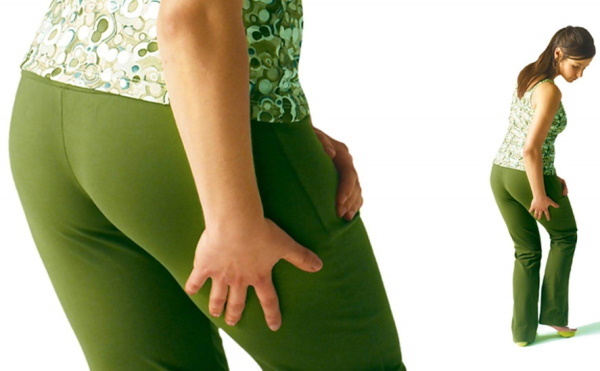
However, with a long course of pathology and the presence of complications, external signs may appear in in the form of a deterioration in the condition of the skin, the appearance of foci of necrosis as a result of malnutrition fabrics. There are no other external symptoms.
Among the signs, a change in the patient's gait can be distinguished. The patient tries to reduce the load on one limb, but in the case of bilateral lesions, the gait changes significantly. Gradually, the patient reduces physical activity, since movements provoke an aggravation of the symptoms of the disease.
There are other manifestations of the inflammatory process:
- Sharp and severe pain when performing physical exercises or ordinary household manipulations. Pain is especially pronounced when the body bends, which is associated with an incorrect distribution of the load on the spinal column. Soreness can bother the patient constantly, but is aggravated during periods of exacerbation. This course of the disorder is characteristic of the chronic form.
- An increase in body temperature as a result of the body's reaction to the inflammatory process. Systemic reactions appear in most patients, but in some cases they are absent.
- Deterioration of mobility, especially in the lumbar spine. At the same time, the sacral region is often involved in the pathological process, which only aggravates the condition.
- Discomfort in the acute stage radiates to one or both legs, depending on the area of the lesion. In this case, the symptoms are somewhat weakened when the patient takes the knee-elbow position.
- Violation or complete loss of sensitivity of the skin of the lower leg, foot and back of the thigh. At the same time, the sensitivity of the inner surface of the thigh is preserved, since this part is not innervated by the sciatic nerve.
- Headache and dizziness. Often, patients have concomitant disorders of the spinal column, therefore, concomitant disorders of the nervous system appear.
- Decreased appetite.
- Fatigue and muscle pain. Symptoms are associated with the fact that with the development of inflammation, the patient unevenly distributes the load on the musculoskeletal system, trying to avoid severe pain.
- Muscle tension in the affected limb. With bilateral inflammation, the tension of the muscle fibers increases.
- Enhanced work of the sweat glands.
- Atrophy of the muscle tissue of the affected limb associated with malnutrition and innervation.
- Forced situation. The patient assumes a posture that somewhat relieves pain and reduces the load on the affected limb.
- Decreased reflexes or their complete disappearance.
Systemic symptoms include impaired digestion, upset stools, and urinary tract disorders. Depending on the presence of concomitant complications in patients, the clinical picture may differ.
Causes
The sciatic nerve is affected by various factors.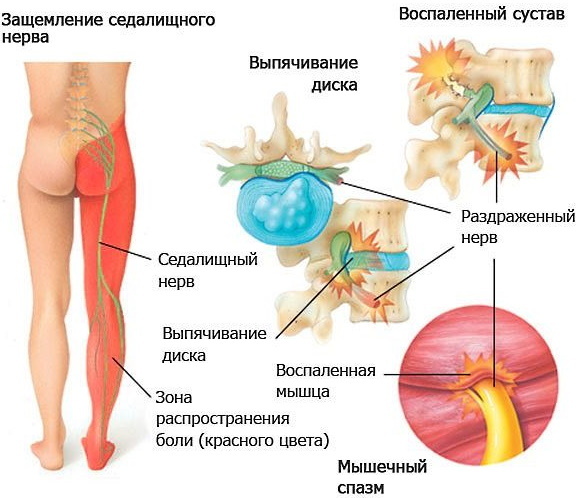
The symptoms of inflammation usually appear against the background of the following reasons:
- Poisoning the body with food, medicine or alcohol. Especially often when taking drugs and alcohol, complications from the nervous system appear, which is associated with damage to nerve cells.
- Inflammatory process of other nerve endings or parts of the spinal cord.
- Osteochondrosis in acute and chronic form.
- The presence of a hernia in one of the sections of the spinal column or several hernias. With severe damage and progression of the disease, sciatica symptoms appear often and provoke concomitant deviations.
- Regular hypothermia of the body, which provokes not only damage to nerve tissues, but also a general weakening of the immune system.
- The presence of osteophytes on the vertebrae, which are a kind of bony processes that appear as a result of an increase in the load on the spinal column and the development of pathologies of the intervertebral discs.
- Osteoarthritis at different stages of development.
- Diagnosing gout.
- Diabetes. It is noted that in patients with such a pathology, sciatica is observed more often, which is associated with damage to the peripheral nervous system.
- Infectious pathologies that can provoke damage to the peripheral nervous system.
- The presence of spinal column tumors in patients.
- Constant and heavy physical activity.
One of the common causes of the disease is considered to be a long stay of the patient in a sitting position, when the load on the lumbar and sacral spine increases. Usually, inflammation is observed in patients who, due to professional activity, are forced to sit or stand in one position for a long time.
During pregnancy, sciatica often develops in women, which is associated with a shift in the center of gravity and an increase in the load on the lumbar spine.
Treatment methods
Sciatic nerve (symptoms of inflammation may appear in patients with no history of musculoskeletal disorders) is the largest in the human body, therefore, its inflammation is accompanied by various acute disorders and requires timely treatment.
When symptoms appear, the patient should visit a doctor who will prescribe a diagnostic examination. Usually, standard methods are used in the form of blood tests, reflexes and X-ray diagnostics. After that, the doctor prescribes treatment, which usually includes medicines, folk remedies and some other methods.
Medications
To eliminate acute pain and prevent the progression of pathology, drugs from the group of painkillers, anti-inflammatory, hormonal are used. Vitamin complexes are often prescribed in which B vitamins are present.
The most effective medicines:
-
Naklofen refers to non-steroidal anti-inflammatory drugs, has pronounced analgesic and anti-inflammatory properties. The drug in the form of a solution is administered intramuscularly at 3 ml per day. The duration of therapy is 3-5 days. The tool quickly relieves the patient's condition, especially in the acute period.
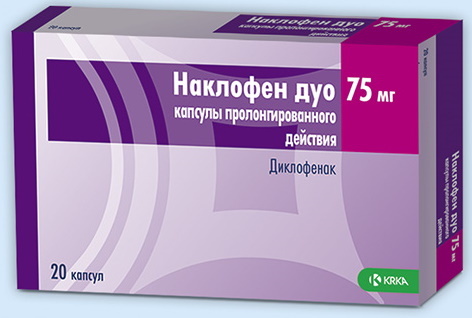
- Ketorol also has analgesic properties, can be used to treat patients in the acute and subacute period. The medication is available in tablet form and as a solution for parenteral administration. The patient can use tablets at home, take 2 pieces per day. The solution is usually administered in a hospital setting, 1-2 ml per day. Therapy with any dosage form usually lasts no more than 7 days.
- Diclofenac it is also considered an effective medication in the acute period. It is administered intramuscularly at 3 ml per day. Injections are given when symptoms worsen or before bedtime, which relieves the patient's condition. The duration of treatment for the patient is determined individually, but in most cases, 5-7 days are enough.
- Nise gel it is allowed to apply in the affected area, that is, on the skin of the lumbar spine. The procedure is carried out at home 2 times a day. When applying, the gel layer should be thin, it should be rubbed into the skin with gentle movements. The treatment course lasts approximately 10 days.
- Neuroubin contains B vitamins, which improve the conduction of the impulse along the nerve endings. When treating, drugs from this group are included in the course, which makes it possible to speed up the healing process and prevent the development of complications. The solution is administered 1 ampoule per day for 10 days. If necessary, the course is extended according to individual indications.
- Dexalgin has pronounced analgesic properties and is usually used in the acute period when the patient is admitted to the hospital. The solution is administered intravenously or intramuscularly, 2 ml per day. The duration of treatment should not exceed 5 days, which is associated with the strong effect of the medication on the body.
Depending on the presence of concomitant abnormalities in patients, the specialist selects other means to prevent their progression. It is not recommended for patients to take medications on their own.
Folk remedies
The sciatic nerve (symptoms of inflammation significantly impair the patient's quality of life) and its pathology cannot be completely cured with the help of traditional medicine recipes. But doctors allow patients to use some methods at home to alleviate the condition.
Compress based on black radish pulp is considered to be quite effective. To carry out the manipulation, it is necessary to grind the radish on a grater. Put a layer of gauze on the lumbar region, put a thin layer of the crushed mass on it. With the next layer of gauze, secure the compress and apply a layer of cellophane or cling film. Leave the compress overnight, repeat the procedures for 7-10 days in a row.
Herbal infusions also help relieve the condition, and have mild analgesic properties. To prepare a healing drink, you will need to take 1 tbsp. l calendula, viburnum and thyme in dried form.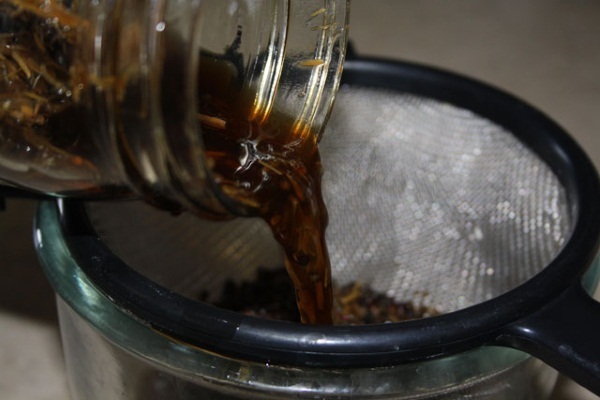
Pour 500 ml of water over the ingredients, simmer for 5 minutes. Take the resulting medicine for 10 days, half a glass 2 times a day. After taking the patient, the patient feels relief, in combination with other means, this helps to shorten the recovery period.
Rubbing the affected area with homemade ointment based on natural ingredients helps to somewhat improve the condition and prevent the progression of the disorder. To obtain the ointment, you need to take 50 ml of black radish juice and 100 ml of natural honey. The ingredients must be thoroughly mixed, rubbed into the affected area and left for 3 hours. It is necessary to repeat the procedures daily until a therapeutic result is obtained. Usually 2 weeks is sufficient.
Traditional medicine recipes are allowed to be used only after consulting a doctor, as they have contraindications and can provoke complications.
Physiotherapy
To accelerate the recovery period, it is allowed to use physiotherapy methods. Usually, in the acute period, they are not used, but after stopping the attack, it is allowed to undergo a full course. Depending on the course of the disease and whether the patient has complications, the doctor determines the specific procedure and the number of sessions.
The most commonly used methods are:
- Paraffin therapy is considered an effective method. The principle of action is the positive effect of warm paraffin on the affected area. For a full course, you will need 10 sessions of 20 minutes at intervals of 2-4 days.
- Electrophoresis helps to relieve residual symptoms of inflammation and associated abnormalities. Low frequency electrical impulse affects tissues and improves nutrition, blood circulation. The procedure is carried out 2-3 times a week, it lasts up to 20 minutes. The course consists of 7-15 sessions.
- Magnetotherapy it is also considered an effective method after the elimination of acute manifestations of a pathological condition. It is carried out 1 to 3 times a week for 15-20 minutes. The essence of the method is the effect of a magnetic field on the affected areas. As a result, the residual signs of the disease are eliminated. To obtain a therapeutic result, you will need 10-12 sessions. This method is allowed to be used only in the absence of acute manifestations, since in the acute stage, symptoms may worsen.
One of the effective methods is therapeutic gymnastics, which helps to restore the affected muscle tissue, weakened during the period of exacerbation of the disease. The set of exercises is selected for the patient individually after examination. Classes begin after the elimination of acute manifestations.
At the initial stage, the lesson lasts 10 minutes, but gradually its duration is increased. It is recommended to do the exercises 2 to 4 times a week, depending on the initial state of the spinal column. If the patient has intervertebral hernias or other pathologies of the spinal column, the decision to perform the exercises is made only by the doctor.
The sciatic nerve often suffers from various pathologies. Symptoms of its inflammation often bother patients of different ages, even in the absence of a history of pathologies of the spinal column and peripheral nervous system. If signs of a disease appear, you should immediately consult a doctor who will prescribe an examination and a treatment regimen suitable for a particular patient.
Video about sciatic nerve inflammation
Sciatica. Symptoms:



